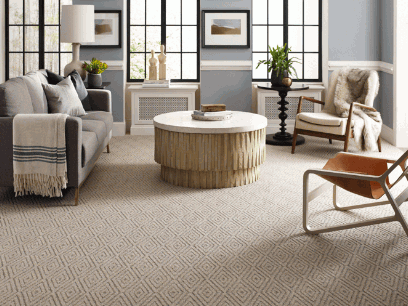Are you tired of your outdated living room flooring? Do you want a durable and stylish option that will withstand everyday wear and tear? Look no further than epoxy flooring! This popular choice has gained popularity for its many benefits, and in this article, we will explore why it's a great option for your living room. Don't settle for subpar flooring, give your living room the upgrade it deserves with epoxy flooring.
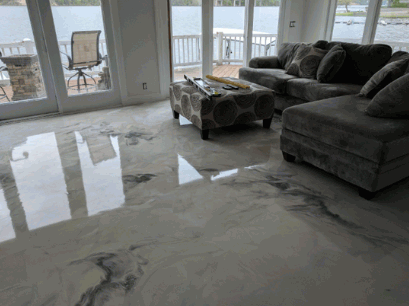
What Is Epoxy Flooring?
Epoxy flooring is a highly durable and versatile option for flooring, commonly used in commercial and industrial settings. It is made from a mixture of resin and hardener, creating a seamless and strong surface. Epoxy flooring is known for its exceptional resistance to chemicals, stains, and heavy foot traffic, making it a popular choice for high-traffic areas. Its glossy and attractive finish is also easy to maintain.
While it is commonly used in commercial spaces, epoxy flooring is gaining popularity in residential settings as well. If you are looking for a long-lasting, low-maintenance, and visually appealing flooring option for your living room, consider epoxy flooring.
What Are The Advantages Of Epoxy Flooring?
Are you considering epoxy flooring for your living room but unsure if it's the right choice? Let's take a closer look at the advantages of this popular flooring option. From its durability and easy maintenance to its resistance to chemicals and stains, epoxy flooring has many practical benefits. But that's not all - we'll also discuss how its versatility in design can add a unique touch to your living room. Get ready to discover why epoxy flooring might just be the perfect fit for your home.
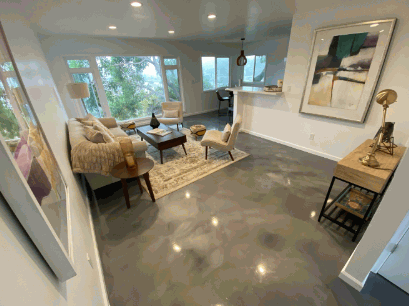
1. Durability
Durability is one of the main benefits of having epoxy flooring. To ensure its long-lasting strength, follow these maintenance steps:
- Regular Cleaning: Sweep or vacuum the floor to remove dirt and debris.
- Spills and Stains: Quickly clean up any spills to prevent staining. Use a mild detergent and water to remove stains.
- Protective Measures: Place mats or rugs in high-traffic areas to protect the epoxy floor from excessive wear.
- Avoid Sharp Objects: Prevent scratches by using furniture pads and avoiding dragging heavy objects across the floor.
- Regular Inspections: Check for any cracks or damage and address them promptly to prevent further deterioration.
2. Easy Maintenance
Maintaining epoxy flooring in living rooms is simple and requires minimal effort. Here are some easy maintenance steps to follow:
- Regular Cleaning: Sweep or vacuum the floor to remove dirt and debris.
- Mopping: Use a mild detergent and warm water to mop the floor. Avoid harsh chemicals.
- Stain Removal: Quickly clean up any spills to prevent stains. Use a gentle cleaner and a soft cloth.
- Preventative Measures: Place doormats at entrances to minimize the amount of dirt being tracked onto the floor.
- Protective Coatings: Apply a wax or sealant to protect the floor's surface and enhance its longevity.
3. Chemical And Stain Resistance
Chemical and stain resistance is one of the key benefits of choosing epoxy flooring. Here are the top reasons why:
- Epoxy flooring creates a seamless, non-porous surface that is highly resistant to chemicals and stains.
- It acts as a protective barrier against spills and contaminants, making it effortless to clean and maintain.
- The flooring is highly resistant to common household chemicals such as oil, grease, bleach, and cleaning agents.
- It prevents stains from penetrating the surface, allowing for quick and easy cleanup.
- Epoxy flooring is an excellent choice for areas that are prone to spills, such as kitchens, garages, and laundry rooms.
- Its chemical and stain resistance contributes to the longevity of the flooring, making it a durable and reliable option.
4. Versatility In Design
Epoxy flooring offers exceptional versatility in design, providing endless possibilities for creating unique and personalized spaces. With epoxy, you have the option to select from a wide range of colors, patterns, and finishes to complement your style and preferences. Whether you desire a contemporary and polished appearance or a more creative and ornamental floor, epoxy can deliver.
Its flexibility also extends to various settings, including residential living rooms and commercial spaces such as offices, retail stores, and even industrial facilities. The design options are truly boundless with epoxy flooring.
Find out more: Advantages of Epoxy Floor Coating
Is Epoxy Flooring Suitable For Living Rooms?
Epoxy flooring can be a great option for living rooms because of its durability, low maintenance, and attractive appearance. It provides a sleek and seamless finish, giving the room a modern and stylish look. Epoxy is also resistant to stains, spills, and scratches, making it perfect for high-traffic areas like living rooms. Additionally, it can withstand heavy furniture without leaving any marks. However, it's important to consider the specific needs and preferences of your living space before deciding on epoxy flooring. Seeking the advice of a professional can assist you in making an informed choice.
What Are The Factors To Consider?
When deciding if epoxy flooring is suitable for your living room, there are several important factors to consider:
- Usage: It is important to assess the amount of foot traffic and potential activities that will take place in the room.
- Climate: Take into account the temperature changes and moisture levels in your area.
- Aesthetics: Consider if the design and finish options of epoxy flooring align with your desired look.
- Maintenance: Evaluate the time and effort required for upkeep.
- Budget: Compare the cost of epoxy flooring to other flooring options.
- Safety: Keep in mind the slip resistance of epoxy flooring, especially if you have pets or young children in the household.
What Are The Potential Drawbacks Of Epoxy Flooring In Living Rooms?
While epoxy flooring has become a popular choice for many homeowners, it may not be the best option for every room in the house. In this section, we will discuss the potential drawbacks of using epoxy flooring in living rooms. These include concerns about the slippery surface, the high initial cost, and the time-consuming installation process. By considering these factors, you can make a more informed decision about whether epoxy flooring is a good fit for your living room.
1. Slippery Surface
A slippery surface on epoxy flooring can be a safety concern, especially in living rooms where there is a higher risk of falls or accidents. To address this issue, consider implementing the following measures:
- Choose an epoxy flooring system with anti-slip additives or textures.
- Regularly clean the surface to remove any substances that may increase slipperiness.
- Place area rugs or mats in areas prone to moisture or spills.
- Increase traction by applying non-slip coatings or grip strips.
- Install handrails or grab bars in areas where balance or stability is a concern.
By following these steps, you can minimize the risk of a slippery surface and create a safer living room environment with epoxy flooring.

2. High Initial Cost
The high initial cost of epoxy flooring is a potential drawback to consider. However, there are steps you can take to manage the expense and make it more affordable:
- Research prices from different suppliers or contractors to find the best deal.
- Consider DIY installation if you have the necessary skills and equipment.
- Opt for a smaller area or partial installation instead of covering the entire living room.
- Look for discounts or promotions that may be available.
Remember, the initial cost may seem high, but it is an investment in the durability and longevity of your flooring. In the long run, epoxy flooring can save you money on repairs and replacements.
3. Time-Consuming Installation Process
Installing epoxy flooring can be a lengthy process, but by following these steps carefully, you can streamline the installation:
- Preparation: Begin by thoroughly cleaning the surface and removing any existing coatings or contaminants.
- Priming: Enhance adhesion between the substrate and epoxy coating by applying a primer.
- Mixing: Follow the manufacturer's instructions to mix the epoxy resin and hardener.
- Application: Use a roller or brush to evenly apply the epoxy mixture onto the prepared surface.
- Waiting: Allow the epoxy to cure and dry according to the recommended drying time.
- Additional Coats: If necessary, apply additional coats, making sure to allow each coat to dry before applying the next.
- Finishing: For added protection and durability, consider adding a topcoat once the final coat is dry.
By carefully following these steps, you can successfully and efficiently install epoxy flooring in your living room.
How To Maintain Epoxy Flooring In Living Rooms?
Keeping up with maintenance for epoxy flooring in living rooms is essential for preserving its durability and appearance. Here are some crucial steps to follow:
- Regularly sweep or vacuum to remove dirt and debris.
- Immediately wipe up any spills with a soft cloth or mop.
- Occasionally scrub the floor with a pH-neutral cleaner and a soft-bristle brush.
- Avoid using harsh chemicals or abrasive cleaners that can cause damage to the epoxy surface.
- Prevent scratches or wear by placing mats or rugs in high-traffic areas.
Pro-tip: To maintain the glossy finish of epoxy flooring, consider applying a thin coat of epoxy floor wax every six months. This will provide an extra layer of protection and enhance its longevity.
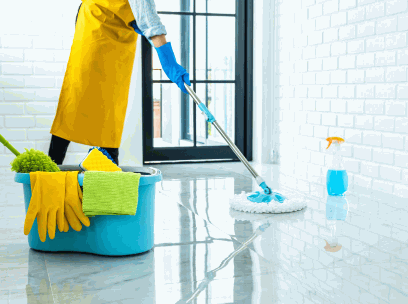
What Are The Alternatives To Epoxy Flooring In Living Rooms?
While epoxy flooring is a popular choice for its durability and low maintenance, it may not be the best option for every living room. In this section, we will explore alternative flooring options that may better suit your needs and personal style. From the classic elegance of hardwood flooring to the affordability of laminate and the cozy comfort of carpet, we will discuss the pros and cons of each alternative to help you make an informed decision for your living room.
1. Hardwood Flooring
When considering hardwood flooring for your living room, follow these steps:
- Assess the available space and consider the size, layout, and natural light in the room.
- Choose the type of hardwood flooring that best fits your style and budget, whether it be solid hardwood or engineered hardwood.
- Take into account the durability and maintenance requirements of different hardwood species.
- Prepare the subfloor by ensuring it is clean, level, and dry before installation.
- Install the hardwood flooring using the appropriate techniques, such as gluing, nailing, or floating.
- Finish the hardwood flooring with a protective coat to enhance its appearance and durability.
- Regularly maintain the hardwood flooring by sweeping, vacuuming, and using suitable cleaners.
Hardwood flooring adds warmth, beauty, and value to your living room while providing a durable and long-lasting option. It offers a wide range of styles, colors, and finishes to suit any design aesthetic. With proper care, hardwood flooring can last for generations, making it a timeless choice for your living room.
Delve into: Can You Do Epoxy Flooring Over Plywood
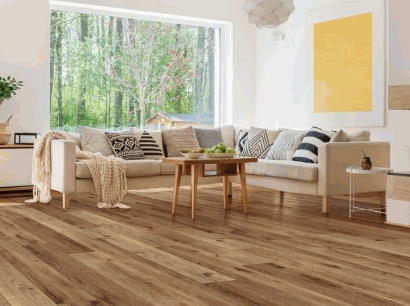
2. Laminate Flooring
Laminate flooring is a popular alternative to epoxy flooring in living rooms. Here are some steps to consider when installing this type of flooring:
- Prepare the subfloor by ensuring it is clean, dry, and level.
- Lay down a foam underlayment to provide cushioning and reduce noise.
- Measure and cut the laminate planks to fit the room, leaving a small gap around the edges for expansion.
- Start laying the planks from one corner of the room, securely interlocking them.
- Use spacers to maintain a consistent gap between the planks and the walls.
- Continue laying the planks row by row, staggering the joints for a more natural look.
- Trim the last row of planks to fit and install baseboards or quarter-round molding to cover any gaps.
- Clean the laminate flooring regularly with a damp mop or microfiber cloth.
- Avoid using excessive water or harsh cleaning agents that could potentially damage the laminate.
When considering laminate flooring, it is important to choose a high-quality product that is waterproof and resistant to scratches and fading. With proper installation and maintenance, laminate flooring can provide a durable and attractive option for living rooms.
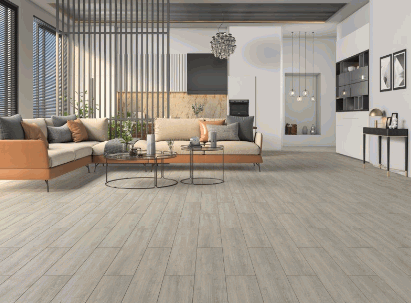
3. Carpet Flooring
When considering carpet flooring for living rooms, here are some steps to follow:
- Measure the space accurately to determine the amount of carpet needed.
- Choose a carpet style that suits your aesthetic preferences and durability requirements.
- Consider the various carpet fiber options, such as nylon, polyester, or wool, based on your desired level of softness and stain resistance.
- Decide on the type of carpet pile, such as cut pile or loop pile, depending on the desired texture and durability.
- Ensure proper installation with the help of professionals to avoid any issues like wrinkles or uneven seams.
- Regularly vacuum the carpet and promptly address any spills or stains to maintain its cleanliness and longevity.
Pro-tip: For added versatility and ease of maintenance in high-traffic living rooms, consider using carpet tiles.
